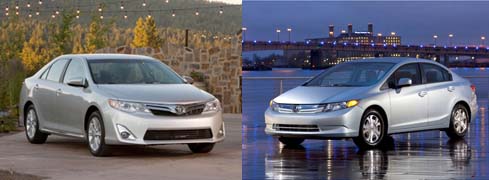The Crank: Japan’s automakers are in catch-up mode
By John LeBlanc
The big stink south of the border last week was the launch of the new 2012 Toyota Camry family sedan (above left). A “big stink” because like Honda’s compact Civic sedan (above right) up here in the Great White North, the midsize Camry has been the perennially best-selling non-pickup new car for something like 13 of the last 14 years. So it’s an important car for Toyota U.S.A. to get “right”.
The family sedan class the Camry competes isn’t as big a deal in Canada. With only 5,968 examples sold through the end of July, the Toyota sits behind the Hyundai Sonata (10,429) and Ford Fusion (12,619) in its class. While the Civic and Hyundai Elantra compacts are battling it out for the overall car title, each selling over 29,000 units each so far this year.
But the launch of the new 2012 Camry is a good indication of not only the health of the Japanese automaker, but also of the type of new product Toyota thinks will resonate with car buyers. And—sadly if you’re a fan of Japanese cars— when you look beyond the PR prattle that Toyota is pushing hard in the U.S. (check out the out-of-context TV ad below), you’ll find Toyota’s idea of what it calls “new” is shocking similar to the same-old, same-old approach Honda took with its so-called “all-new” 2012 Civic I drove in April.
Let’s start with the “new” looks of the Camry and Civic. Now, not uncommon in the industry, automakers get about eight years out of a platform. So the 2012 Camry and Civic reside on essentially the same architectures (dimensions, suspensions, etc.) that debuted for 2007 and 2006, respectively. Any gains in interior space are incremental. Any styling changes are essentially cosmetic. When compared to the more forward-looking cars coming from Hyundai-Kia Motorsand Ford, in both cases the new Camry and Civic are steps back in exterior design. In fact: the 2012 Camry’s simplified lines remind me eerily of the tapioca pudding look of 2002-2006 versions…
But what about what’s underneath this pair of one-time sales emperors’ sheetmetal and plastic? Unfortunately, while both Toyota and Honda have been racking up sales with these two cars, not much money has been put back into innovative powertrains. Except for mildly updated low-volume hybrid versions, the new Camry and Civic continue to offer essentially carryover engines and transmissions. So while rivals offer direct-injection and turbocharging under the hood or dual-clutch automatic transmissions, Honda and Toyota still think their loyal customer base will be happy with last year’s (and the year before that, and the year before that…) engineering.
Now, with all this time in between new versions, one could think Toyota and Honda would respond to the competition in regards to the growing sophistication of ride and handling that’s sweeping the industry. Well, erm, not exactly.
I’ve only had firsthand experience with the 2012 Civic. And somehow (maybe in an attempt to make it “grown up”?) Honda has managed to take all of the fun out of what was previously a nimble and alert car to drive. I haven’t had any seat time with the 2012 Camry yet. But reports in the U.S. suggest that it remains the sensory depravation chamber its customers seem to enjoy. If you want a fun-to drive family sedan, better stick to a Fusion, Mazda6—or my current fave—theKia Optima.
At least for the legions of loyal Civic and Camry owners, there are few surprises with this pair. In the end, both Honda and Toyota have made incremental improvements on what were admittedly decent cars. But if you’re looking for cutting-edge styling, engineering innovation, or a joie de vivre driving experience, the “new” 2012 versions of the Civic and Camry are not those cars.
But do you think this is good enough?
Do think Toyota and Honda have done enough to keep their respective best-sellers at the top of the charts?
Or have these Japan’s automakers moved into catch-up mode?






![[del.icio.us]](https://www.straight-six.com/wp-content/plugins/bookmarkify/delicious.png)
![[Digg]](https://www.straight-six.com/wp-content/plugins/bookmarkify/digg.png)
![[Facebook]](https://www.straight-six.com/wp-content/plugins/bookmarkify/facebook.png)
![[Google]](https://www.straight-six.com/wp-content/plugins/bookmarkify/google.png)
![[Reddit]](https://www.straight-six.com/wp-content/plugins/bookmarkify/reddit.png)
![[StumbleUpon]](https://www.straight-six.com/wp-content/plugins/bookmarkify/stumbleupon.png)
![[Twitter]](https://www.straight-six.com/wp-content/plugins/bookmarkify/twitter.png)
![[Email]](https://www.straight-six.com/wp-content/plugins/bookmarkify/email.png)